Zeynep Uğur is a PhD Candidate in Political Science at École des Hautes Études en Sciences Sociales, Centre d’études sociologiques et politiques Raymond Aron (CESPRA) and currently working as a research assistant in PublicDemoS Project (NOMIS-EHESS) led by Nilüfer Göle. Her dissertation research focuses on public culture in Turkey in the period post-2000 and how it becomes a battle ground of politics through the lens of theater in particular.
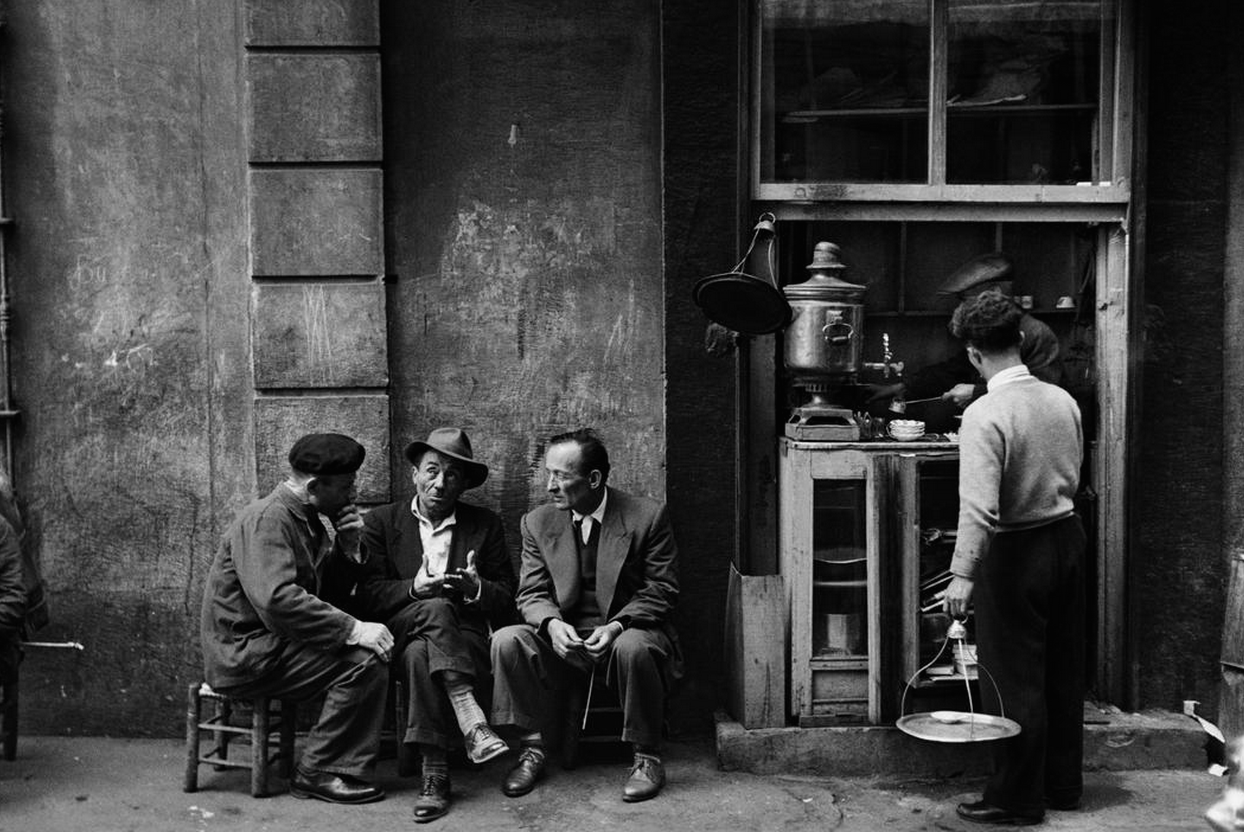
Ara Güler, the world famous photographer born in 1928 in Istanbul passed away on the October 17, 2018. His remarkable career encompassed photographs from around the world, portraits and interviews of politicians and celebrities such as Pablo Picasso, Salvador Dali, Winston Churchill, Alfred Hitchcock, John Berger, Bertrand Russell, James Baldwin and many more. Güler was an example of a cosmopolitan artist who was integrated into transnational networks of artists, while being simultaneously rooted in his hometown of Istanbul. He had a site-specific presence in “his” district of the city, Beyoğlu, one of Istanbul’s most cosmopolitan neighborhoods that for centuries has been a diverse melting pot of the different communities that lived across the Ottoman Empire, including Armenians like Güler.
Historian Edhem Eldem defines the “embedded cosmopolitanism” in Beyoğlu in the 19th century as consisting not only of the mere juxtaposition of diverse actors, but by a cosmopolitan cultural milieu that in turn transformed them as well. Besides visually documenting the district, Güler also was an integral component of its cosmopolitan culture, with his studio and archive, situated in the heart of Beyoğlu, on Istiklal Street. Next to it, there is Ara Café named after him, a café frequented by artists, students, expats, and intellectuals where you could see Ara Güler himself very often before his passing.
Among the variety of his photographic work, Güler is mostly associated with his city Istanbul, and was even given the nickname “The Eye of Istanbul”. Meticulously documenting this city marked by mind blowing transformation, he left a heritage of visual urban memory. This article aims to explore Ara Güler’s photographic work as a visual guide to comprehending Istanbul’s journey of modernization and urbanization in the 20th century.
Our focus is Güler’s portrayal of Istanbul in black and white in 1950s and 1960s, where Istanbul appears as a metropole “in progress”, or under construction. As described by the sociologist Nilüfer Göle, in the context of non-Western countries modernization, involves a cultural shift, a process of changing habitus, aesthetic norms, values, and lifestyles in the public sphere. The economic development of the country goes along with this social and cultural transformation. In 1950s and 60s Turkey, the construction of highways and railways connected the national periphery to the center. Istanbul received a mass wave of migration and expanded with slums during this improvised, unplanned urbanization process. The city became the scene where center and periphery, modern and traditional lifestyles encountered, confronted, and transformed one another and found ways to coexist. Urban poverty became an issue with this contrast becoming more and more visible in the city.
My Prostitute Love (Vesikalı Yarim (1968), the cult movie directed by Ömer Lütfi Akad, depicts the emerging social issues of 1960s Istanbul through the lens of a poetic and impossible love story between a greengrocer and an escort. In this movie influenced by French and Italian new wave, Istanbul is not a simple background, but the protagonist of the movie, a transforming urban space making Halil and Sabiha’s encounter possible. Halil is a simple man, married to a traditionally veiled “village” woman subordinate to him and the mother of his children. He is dragged out of his neighbourhood to a casino in Beyoğlu by his friends and discovers the neighborhood’s emerging nocturnal scene, where women drink with men, a new type of socialization. There he sees Sabiha, a blond escort with heavy makeup, smoking and drinking. He falls immediately in love with this feminine and modern looking woman from beyond his world. He starts to drink, frequenting the nocturnal scene of Beyoğlu and detaching himself from his family. The impossibility of their love not only comes from their different moral values, but also them living in different spatialities and temporalities in the same city. These different temporalities are powerfully exposed by Güler in his photography.
Türkan Şoray and İzzet Günay as Sabiha and Halil in Vesikalı Yarim, Ömer Lütfi Akad (1968).
Güler starts from the micro level, photographing people in their small routines: working, smoking, having a cup of tea, coffee, or an alcoholic drink. These people can be defined as the urban poor, not synchronized with the rapid urban growth and the modern ideal of progress. They are portrayed in the public sphere rather than in the intimacy of their private sphere. Their eyes, facial expressions, hands, and postures incarnates their poverty, highlighting modes of being that contrast sharply with the Westernizing public sphere they have entered. An emotional relation is established between people and the space they inhabit by enacting the space in the body and the body in the public sphere, hence humanizing the city and spatially contextualizing the people. As Jacques Lecoq announces in his pedagogy of movement in theater, only the body engaged in the work can feel, and thus reflect the evidence of the space. Güler’s urban poor portrayed in their work express the social reality with their bodies.

The relation between human body and urban space is particularly staged in work and places of leisure. Güler often portrayed professionals; workers, repair men, shopkeepers, fishermen, bargemen, boatmen, etc. as they worked. These are craftsmen, working with their hands and heads before these two were separated by modernity and the mechanization of labor. Craftsmanship is based on the impulse of doing a work well, developing a skill through training and practice. Physical acts of repetition and practice develop skill from within and reconfigure the material world through a slow process of metamorphosis.
Richard Sennett distinguishes the singularity of craftsmen’s work places, workshops, as productive and autonomous spaces reproducing a hands-on transmission of knowledge from generation to generation. These spaces are not products of spontaneous, mindless occurrence. Craftsmen observe and experiment with tools in relation to their own bodies. Workshops have always glued people together through work rituals consisting on transmission of knowledge by personal contact. Most of these professions don’t exist anymore or were transformed with machines replacing handwork. The work loses its centrality on the organization of daily life and public time. Güler thus becomes a pioneer by constituting a visual source of modernization process.



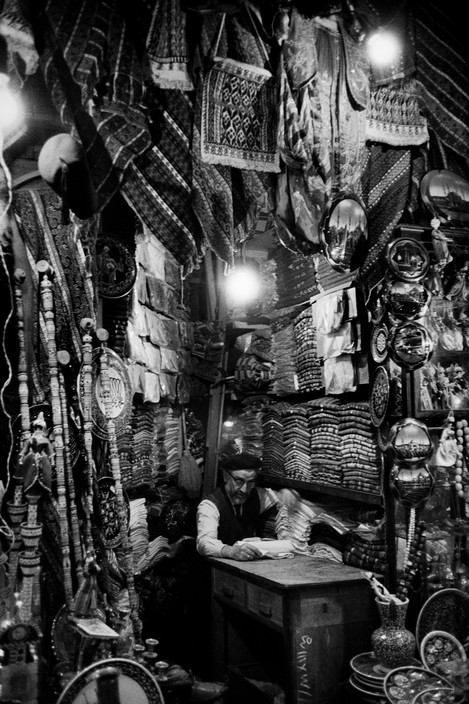
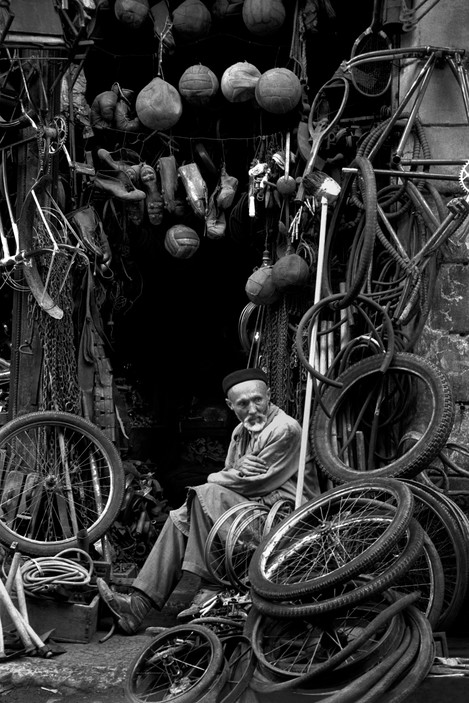

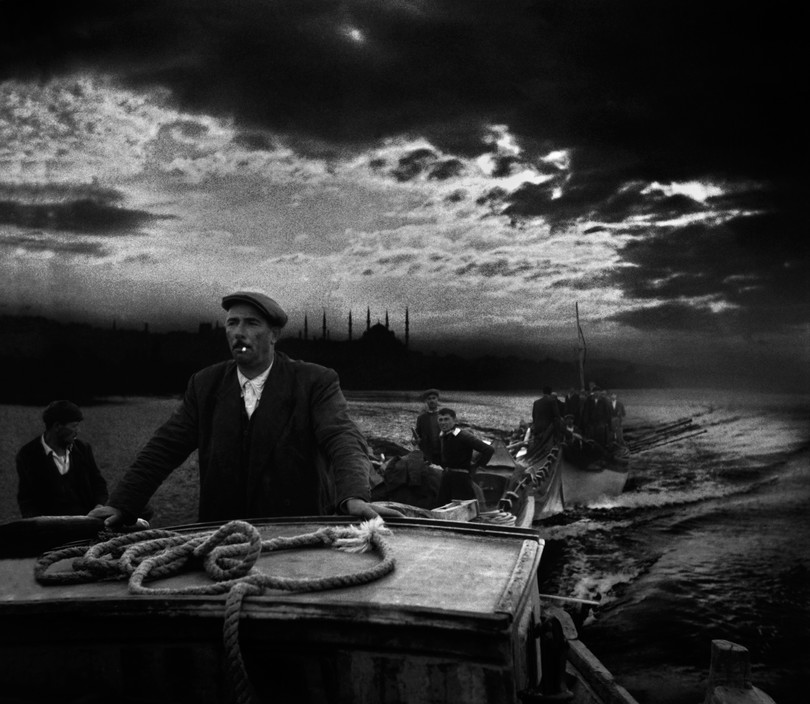
People are also photographed in coffee shops and old fashioned bars where they socialize. Coffee shops have a particular significance in Istanbul’s urban culture, as they emerged as alternative public spheres to mosques in the 16th century. Coffee houses became popular by offering a venue for social occasions including leisure and political dialogue between men in the Ottoman world, thus creating a public culture, as noted by the historian Cemal Kafadar. As gender-mixed modern coffee houses gained popularity, traditional kahvehane became considered places of unproductive time pass activity. These alternative spaces, in turn, become a shelter for men alienated from the emerging modern public sphere and lifestyles. Güler’s men in coffee houses are “waiting”, as the opposite of circulating or producing that increasingly characterized the fast rhythm of the modern city.
In the absence of plans in the present and for the deferred future, a temporal slowing manifests itself. Hence, it points out to a suspension referring to the interruption of social ties, the feeling of being cut-off, a sense of disbelonging, being removed from the context, being out of place, a sense of invisibility, immobility and arbitrariness. These traits resonate with people waiting in the photographs, who seem slightly erased, detached from the space and time surrounding them. Güler’s choice of décor, the Ottoman ruins, emphasizes this detachment by fixing our regard on the remains of the past embodied in the present and the obsolete corners of the city, not “illuminated” yet by the city lights.


Perhaps this is the very reason why Güler’s Istanbul appears as the visual reflection of the Nobel winning author Orhan Pamuk‘s description of the grayscale Istanbul, marked by the feeling of hüzün. Comparable to Baudelaire’s description of Paris Spleen, hüzün is a feeling of melancholia, nostalgia and loss in a multilayered city where multiple spatialities and temporalities are superposed. Guler’s photography reflects this singularity of Istanbul, its vibe and the ambiance experienced when wandering in the city. Given that urban heritage is never patrimonialized and the events of the imperial and republican past haven’t been confronted, they haunt city’s present.
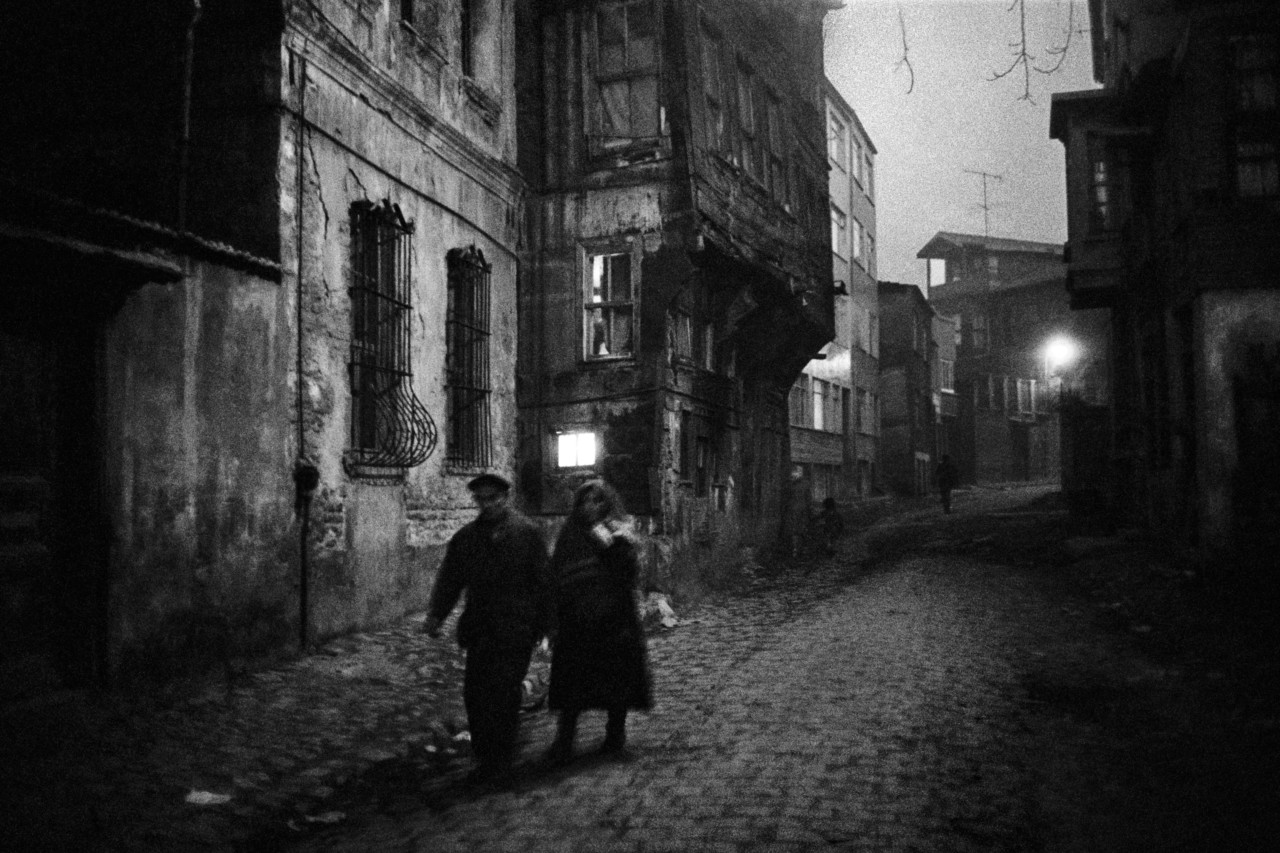


An incarnation of this feeling can be traced in Pamuk’s novel A Strangeness in My Mind. Mevlüt, the protagonist, could perfectly fit in one of Güler’s photographs as a craftsman, selling boza (a wheat based traditional drink) and wandering the streets of Istanbul. While Mevlüt strolls in the city, the layers of past and the transforming present unfold before him. We observe the development of Istanbul from 1950s from the eyes of Mevlüt, who migrates to Istanbul and becomes a slum dweller, gradually alienated from the city and becoming rapidly outdated. Another person who shares the same fate is the lottery seller in a documentary on Narmanlı Han. He sits in the courtyard of the building that had been one of Istiklal Street’s key buildings until its unfaithful restoration, talking about the past: “We would sit here, we would walk around, we would come back to sit again…” The expression otururduk (we would sit) is repeated many times, showing the repetitive rhythm of the now out-of-time sociability.
Ara Güler might be referred as a Proustian in search of lost time, however his madeleine would be persons; the urban poor in the streets of Istanbul. His quest to seize what is being lost is not an interior process of romanticization, but comes from the external world. He always insisted that he is not an artist who proposes an interpretation of reality, but a visual archivist who documents life as it exists. In his photographs, it is the people who craft the urban sphere by sitting, waiting, settling, investing, appropriating it. Güler composes the cityscape of Istanbul by parting from the margins to join the center, the core of the city. This composition identifies the singularity of Istanbul, hüzün, a feeling of loss of firm ground, a loss of an emotional root, which opens up a wide range of emotions and experiences.
Sources
Sibel Hurtas, “What’s behind Erdoğan’s Promise of Free Coffee Houses?”, Al-Monitor, 21.06.2018.
Jacques Lecoq, Le corps poétique un enseignement de la création théâtrale, Paris, Actes Sud, 2016.
Orhan Pamuk, “I like your photographs because they are beautiful”, New York Times, November 1 2018.
Richard Sennett, The Craftsman, Yale University Press, 2008.









